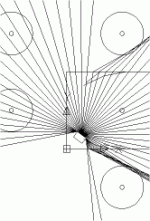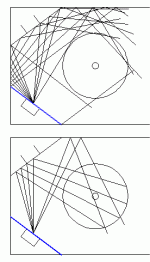I was trying to combine it with some CD racks in a basement. Basically still try to do some absorption of reflected waves after they have traveled to the back of the room while still applying a similar concept to reduce reflections from the back wall reflecting back to the listening area.No takers on building to this concept, eh?
It answers what has been forward as an ideal in this thread: You can have a lively room and speakers of any directivity, including wide directivity, while still achieving a dead period in terms of early reflections.
The author gets lower early energy than you could achieve with diffusors. Probably lower than you could get with especially directional speakers. You could also use the concept with dipoles to good advantage. Since they send little energy to the sides where it would contribute to spaciousness, and much to the rear wall where it can cause problems, this approach would let you redirect the energy in a more beneficial direction.
You also don't need as complex a surface as this. If you have a well defined seating position you can simply put large reflectors at the wall bounce points of the reflections you want to "divert". Plus diffusors at points where you want reflections from (wide sidewall angles).
You could certainly experiment with free standing plywood reflectors, or even foam core.
David S.
I was doing some tracing yesterday and as you can see from the attached image, by doing little more than extending the flat baffle out until it touches the side and rear walls I could be redirecting the rear and both sides.No takers on building to this concept, eh?
You have the plane of your reflector sheets pointed back at the speakers, ie. they are not broadside toward the speakers, is this correct?My ceiling diffusor is basically along these same lines and I can tell you that it works,
I would have assumed the opposite, but then that would produce a Freznel style reflector (with frequency limitations) and I guess yours wouldn't be acting that way?
Attachments
Don't be in such a hurry! I studied the paper while traveling, I need to look again.No takers on building to this concept, eh?
While I do like the concept - and my room is of a very similar size - but I ain't sitting anywhere near that close. So I'd have to figure out how and if it would work for my listening position in my room. I do not want to sit that close to the speaker wall. Would you?
What we need is a freeware method to measure ETC (energy time curve,the plot of reflections. Has anyone seen one?)
David
Arta can plot an ETC.
Arta can plot an ETC.
Yep, the free demo of ARTA will measure and plot ETC. You can't save the original impulse response to a file for later re-use (without registering) but you can copy and paste any number of ETC curves from the current measurement as image files without limitation.
Last edited:
Not freeware. No I haven't. I'm trying the control room in the BBC paper in CARA software, and will post results as soon as I can.
Was dave asking for software to measure ETC of actual rooms, or to predict it from simulations ? I'm confused...
REW shows ETC and is a freeware. It has all the features one need for small room acoustics.
REW - Room EQ Wizard Home Page
A comment to what was said earlier. Localization error will happen no matter how the recording is if the room has a complete dampened rear wall. It doesn't only sound unatural because it's dead, but it's also incorrect due to how we perceive sound. This has been known for a long time.
REW - Room EQ Wizard Home Page
A comment to what was said earlier. Localization error will happen no matter how the recording is if the room has a complete dampened rear wall. It doesn't only sound unatural because it's dead, but it's also incorrect due to how we perceive sound. This has been known for a long time.
A comment to what was said earlier. Localization error will happen no matter how the recording is if the room has a complete dampened rear wall. It doesn't only sound unatural because it's dead, but it's also incorrect due to how we perceive sound. This has been known for a long time.
If by "rear wall" you mean the wall behind the speakers, then your comment is contrary to both my experience (I do precisely that) and Floyd Tooles (see his book).
I mean the wall behind the listener.If by "rear wall" you mean the wall behind the speakers, then your comment is contrary to both my experience (I do precisely that) and Floyd Tooles (see his book).
Was dave asking for software to measure ETC of actual rooms, or to predict it from simulations ? I'm confused...
For measurement of actual rooms. I want to see what my 2 rooms measure like and then see how practical it is to deal with particular reflections.
David
I can't find anywhere in Holm to generate ETC graphs.As will HomImpulse. My preference is Holm because its full capability is free.
While I agree Holm is a great tool if your budget is "for free", it really can't compete with ARTA in either functionality or usability.
ARTA has a full suite of room acoustic measurement tools that Holm lacks, and for measurements that both programs can do I generally find ARTA does a much better more accurate job of it and is easier to use.
The free version just prevents you from saving impulse response measurements permanently to a file - not something that's really an issue for a quick test proposed in the thread - it will still let you take a measurement and generate any ETC (or other) results from that and save the end results including copy/pasting graphs into jpeg/png. (You just can't go back later and generate more results from the original measurement once the program/impulse response is closed, unless you re-measure)
Last edited:
- Status
- This old topic is closed. If you want to reopen this topic, contact a moderator using the "Report Post" button.
- Home
- Loudspeakers
- Multi-Way
- What is the ideal directivity pattern for stereo speakers?

